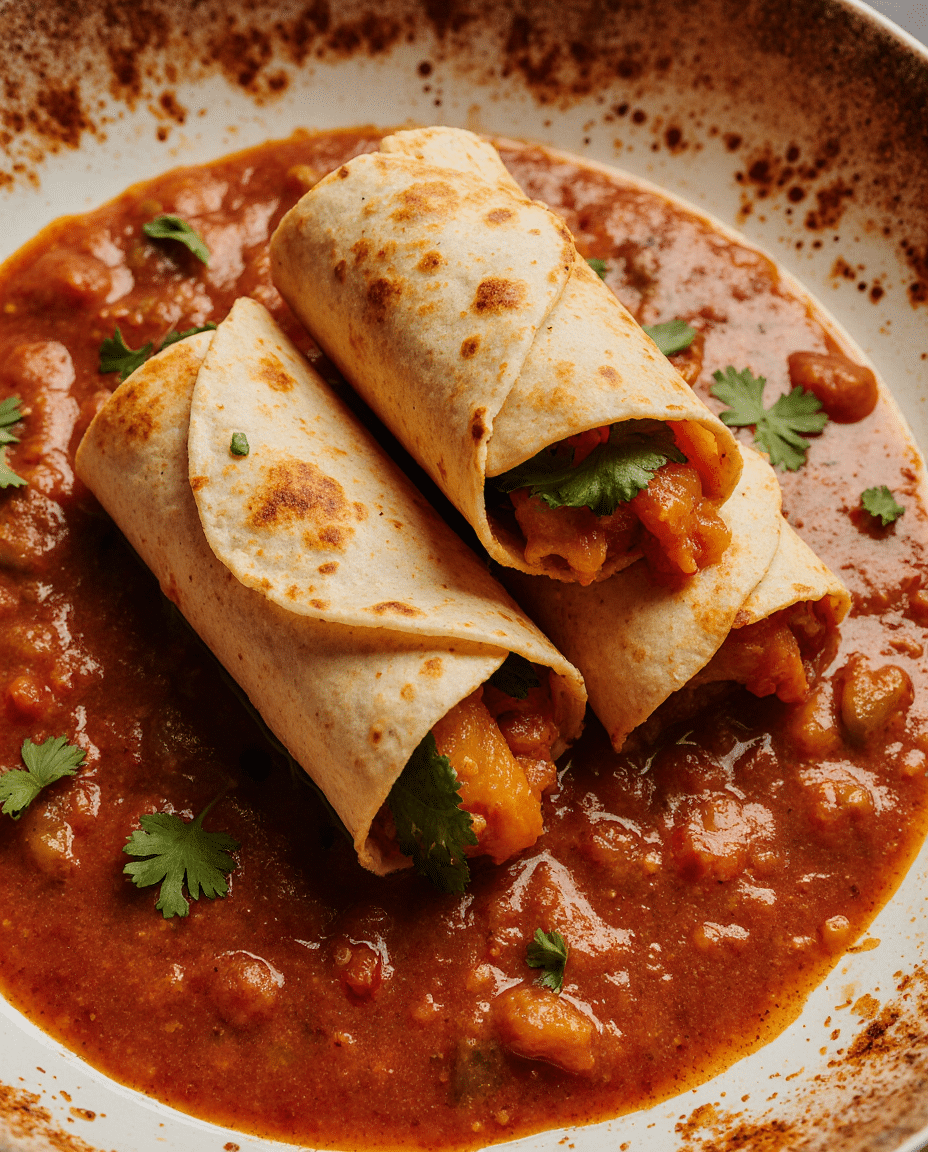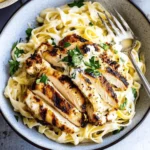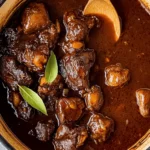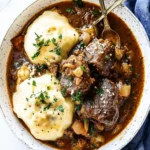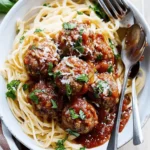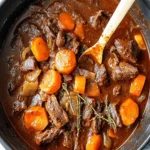Enchiladas Rojas (red) and Verdes (green) are iconic Mexican comfort foods that bring vibrant color and bold flavor to any festive table. Whether smothered in a smoky red chili sauce or a tangy green tomatillo blend, these rolled tortillas are typically filled with shredded chicken, cheese, or beans, then baked until bubbling.
FULL RECIPE
Ingredients
1.For the Red Sauce (Enchiladas Rojas):
- 4 dried guajillo chilies, stemmed and seeded
- 2 dried ancho chilies, stemmed and seeded
- 2 cups hot water (for soaking chilies)
- 2 cloves garlic
- 1/4 onion
- 1/2 teaspoon cumin
- 1/2 teaspoon oregano
- Salt to taste
- 1 tablespoon vegetable oil
2.For the Green Sauce (Enchiladas Verdes):
- 1 pound tomatillos, husked and rinsed
- 2 fresh serrano or jalapeño peppers
- 1/4 onion
- 2 cloves garlic
- 1/4 cup fresh cilantro
- Salt to taste
- 1 tablespoon vegetable oil
3.For the Enchiladas:
- 12 corn tortillas
- 2 cups cooked shredded chicken or cheese (or a mix)
- 1/2 cup crema or sour cream
- 1/2 cup crumbled queso fresco or shredded cheese
- 1/4 cup chopped white onion
- Fresh cilantro leaves, for garnish
- Vegetable oil, for frying tortillas
Directions
- Make the Red Sauce:
Soak the dried chilies in hot water for 15 minutes until softened. Blend with garlic, onion, cumin, oregano, and a pinch of salt using some soaking liquid until smooth. Heat 1 tablespoon of oil in a saucepan, pour in the sauce, and simmer for 10 minutes until thickened. - Make the Green Sauce:
Boil tomatillos and chilies for about 10 minutes until soft. Blend with onion, garlic, cilantro, and salt until smooth. Heat 1 tablespoon of oil in a saucepan, pour in the sauce, and simmer for 10 minutes. - Prepare the Tortillas:
Lightly fry each tortilla in oil for a few seconds per side until soft. Drain on paper towels to remove excess oil. - Assemble the Enchiladas:
Preheat the oven to 350°F (175°C). Dip each tortilla in your preferred sauce (red or green), fill with shredded chicken or cheese, roll tightly, and place seam-side down in a baking dish. - Top and Bake:
Pour extra sauce over the rolled tortillas. Sprinkle with cheese and chopped onion. Bake for 15–20 minutes until heated through and cheese is melted. - Garnish and Serve:
Top with crema, queso fresco, and cilantro. Serve hot with rice and beans or a fresh salad.
Nutrition Facts
- Calories: 360
- Protein: 18g
- Total Fat: 18g
- Saturated Fat: 6g
- Cholesterol: 55mg
- Sodium: 620mg
- Total Carbohydrates: 30g
- Dietary Fiber: 5g
- Sugars: 3g
- Vitamin A: 20% DV
- Vitamin C: 25% DV
- Calcium: 15% DV
- Iron: 10% DV
Cultural Relevance of Enchiladas Rojas and Verdes
Enchiladas Rojas and Verdes are an essential part of Mexican culinary heritage, deeply rooted in regional and national traditions. These dishes have been passed down for generations and are especially cherished during national celebrations like Mexican Independence Day. The red and green sauces mirror the colors of the Mexican flag, making them a patriotic staple during festive gatherings. While Enchiladas Rojas are often associated with the earthy and smoky flavors of central and southern Mexico, Enchiladas Verdes showcase the fresh tang of tomatillos common in the cuisine of the country’s central highlands.
Difference Between Red and Green Enchiladas
The primary difference between Enchiladas Rojas and Verdes lies in their sauces. Red enchiladas use dried chilies such as guajillo and ancho, which provide deep, smoky flavors and a slightly sweet undertone. In contrast, green enchiladas rely on tomatillos and green chilies like jalapeños or serranos, offering a tangy, vibrant, and slightly spicy flavor. Each version offers a unique taste experience and can be adapted to different palates—red for those who enjoy bold, robust sauces and green for those who prefer a zestier, fresher taste.
Health Benefits and Nutritional Highlights
Enchiladas can be a wholesome and balanced meal when prepared thoughtfully. The dish provides a good source of lean protein when filled with shredded chicken or beans. Tomatillos, used in green sauce, are high in vitamin C and antioxidants, while chilies in both versions contain capsaicin, which supports metabolism and inflammation control. Corn tortillas contribute fiber and essential minerals like magnesium. When topped with moderate amounts of queso fresco and crema, enchiladas can offer both flavor and important nutrients like calcium, though portion control is important due to potential sodium and fat content.
Versatility in Fillings
One of the strengths of enchiladas is their versatility. While shredded chicken is a traditional filling, beef, pork, beans, vegetables, and even seafood can be used. Cheese-only enchiladas are a vegetarian favorite and offer rich flavor with minimal ingredients. Roasted vegetables such as zucchini, mushrooms, and bell peppers can make the dish lighter while maintaining heartiness. The adaptable nature of enchiladas allows for creative experimentation and seasonal customization, making them suitable for a variety of dietary needs and preferences.
Tips for Preparing Sauces from Scratch
Making red or green sauce from scratch enhances the authenticity and depth of the enchiladas. For the red sauce, soaking dried chilies before blending allows them to rehydrate and release their complex flavors. Toasting them lightly beforehand intensifies their smokiness. For the green sauce, boiling tomatillos softens their texture while preserving their tartness. Blending fresh cilantro, onion, and garlic into either sauce creates layers of aroma and taste. Simmering each sauce after blending ensures a smooth, cohesive consistency and helps meld all the ingredients together.
Assembly and Baking Techniques
To prevent soggy enchiladas and preserve their texture, each tortilla should be lightly fried before assembly. This creates a barrier that holds up to the sauce. Dipping tortillas in warm sauce before filling helps them become pliable and ensures even flavor. Rolled enchiladas should be arranged tightly in the baking dish to retain shape and avoid drying out. Pouring extra sauce on top before baking helps maintain moisture and enhances flavor. Baking at a moderate temperature ensures that the fillings are heated through without overcooking the tortillas.
Serving Suggestions and Sides
Enchiladas pair wonderfully with a variety of traditional Mexican sides. Classic accompaniments include Mexican rice, refried or black beans, and simple green salads dressed with lime vinaigrette. Sliced avocado, pickled onions, or a side of radishes add brightness and contrast. A dollop of crema or a sprinkling of queso fresco balances the spice and adds creaminess. Serving with lime wedges allows guests to adjust acidity to their liking. For a festive table, including both red and green enchiladas gives visual appeal and a broader flavor range.
Beverage Pairings
For beverages, enchiladas can be complemented by both alcoholic and non-alcoholic options. A light Mexican lager or amber ale helps temper the heat and richness. Micheladas—a beer cocktail with lime and chili—are a festive match. For wine lovers, a medium-bodied red like Tempranillo or a crisp white like Sauvignon Blanc pairs well with the tangy and spicy notes. Agua frescas made from tamarind, hibiscus, or lime offer refreshing, family-friendly alternatives that echo the dish’s vibrant flavors.
Make-Ahead and Storage Advice
Enchiladas can be prepared ahead of time and stored for convenience without compromising flavor. To make in advance, fill and roll the tortillas, then cover and refrigerate without adding sauce until ready to bake. The sauces can be made up to two days ahead and stored separately. When ready to serve, pour the sauce over the enchiladas and bake. Leftovers can be refrigerated in an airtight container for up to 3 days. Reheat in the oven or microwave, adding a bit of fresh sauce or broth to prevent dryness.
Advertisement
Creative Twists and Modern Variations
Modern takes on enchiladas include gluten-free versions using grain-free tortillas, dairy-free options with plant-based cheese and crema, and fusion styles that incorporate global flavors. Some cooks experiment with mole sauce, enchiladas filled with quinoa, or using roasted poblano peppers for a smoky green twist. Breakfast enchiladas filled with scrambled eggs, potatoes, and chorizo have also gained popularity. These variations make enchiladas adaptable to changing tastes and dietary needs while preserving the spirit of the original dish.
Conclusion
Enchiladas Rojas o Verdes are more than just comforting meals they’re colorful, flavorful expressions of Mexican identity and hospitality. Whether you prefer the smoky depth of red sauce or the tangy brightness of green, these saucy tortilla rolls are endlessly customizable and crowd-pleasing. Perfect for festive occasions like Mexican Independence Day or casual family dinners, enchiladas invite creativity in the kitchen and joy at the table.

